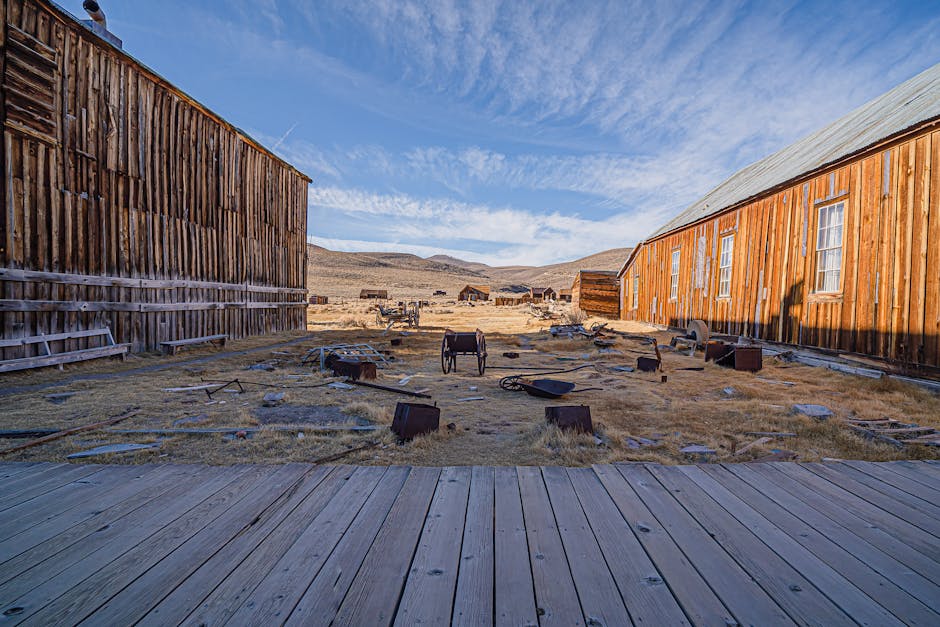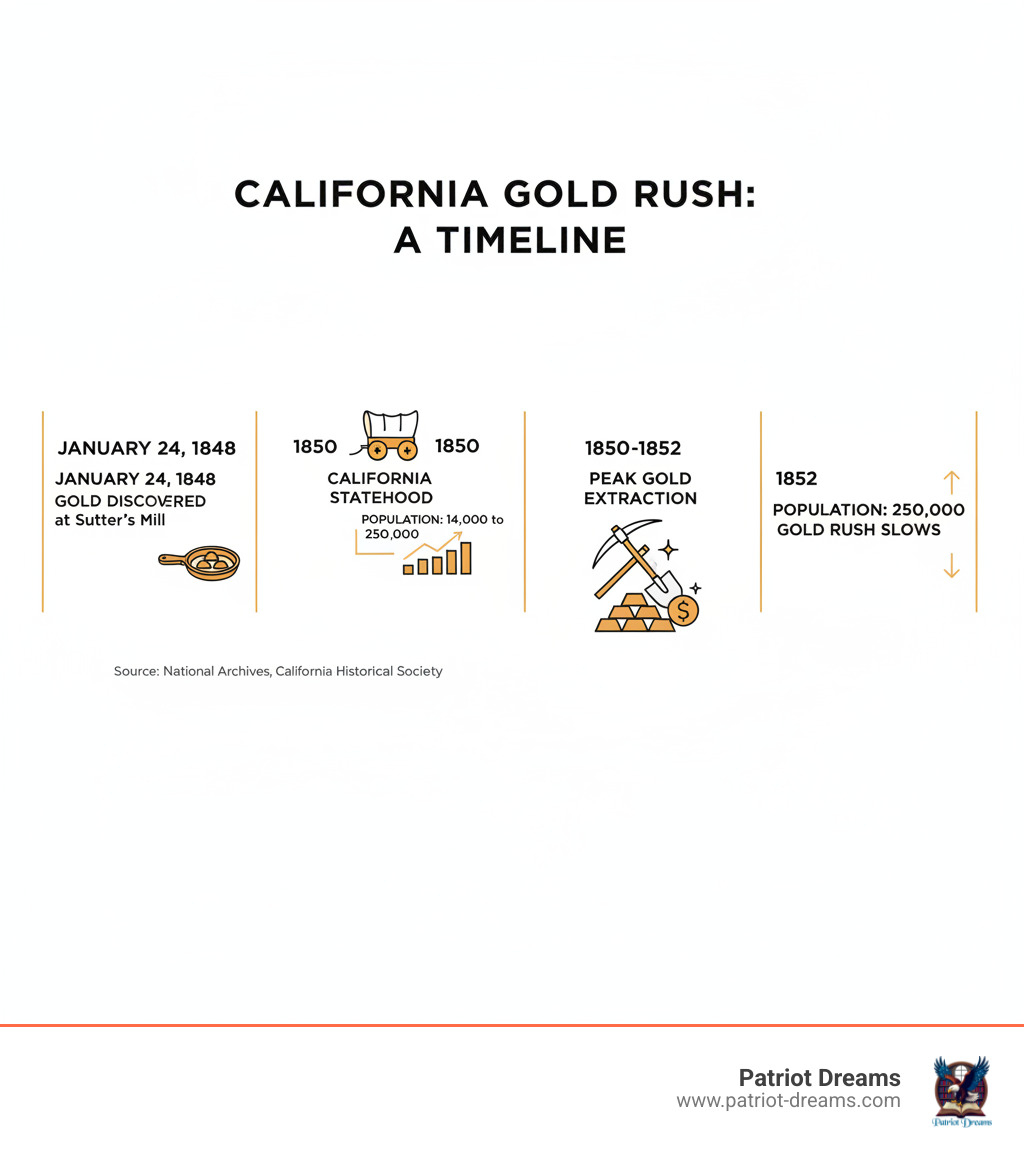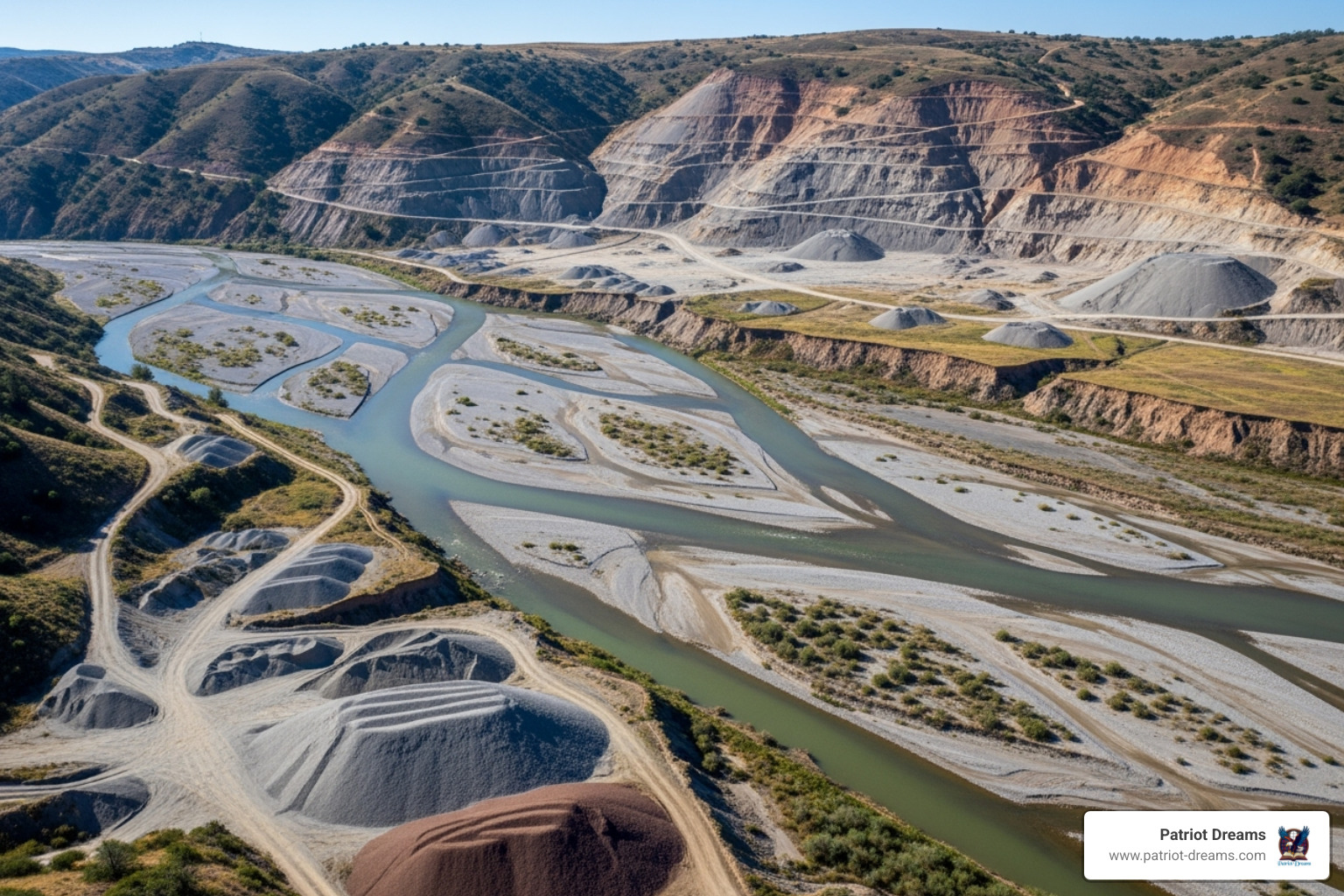California Gold Rush: The Definitive Guide to America's Golden Era

A Spark That Ignited a Nation
The California Gold Rush was a transformative period in American history that began on January 24, 1848, when James W. Marshall found gold at Sutter's Mill in Coloma, California. This findy triggered one of the largest migrations in United States history, bringing approximately 300,000 fortune-seekers to California and rapidly changing the region from a quiet territory into a thriving state.
"I reached my hand down and picked it up; it made my heart thump, for I was certain it was gold," James Marshall later recalled. His find would change not just his life, but the course of an entire nation.
The story of the Gold Rush is one of hope and hardship, of ordinary people chasing extraordinary dreams. These weren't just prospectors—they were families leaving everything behind, pioneers crossing treacherous terrain, and communities forming in the wilderness. They were merchants, builders, and immigrants from around the world who helped lay the foundation of modern California.
The rush for gold also came with tremendous costs. Native American populations were tragically displaced, the environment was harmed, and many prospectors faced disease and disappointment instead of fortune.
Yet through it all, something remarkable happened. California grew into the 31st state in just two years. Cities rose from nothing, and the spirit of the "Forty-Niners"—their optimism, resilience, and willingness to take a chance—became a cherished part of the American character.

The Glimmer of Gold: A Secret That Couldn't Be Kept
It began on a quiet morning in January 1848. James W. Marshall, a carpenter building a sawmill for John Sutter on the American River, noticed tiny flecks glinting in the water. "It made my heart thump, for I was certain it was gold," he later recalled. Sutter and Marshall tried to keep the findy a secret, fearing a rush of prospectors would overrun their lands. But some secrets are too big to hold.
Word leaked out, and soon, a San Francisco merchant named Samuel Brannan strode through the streets, holding up a bottle of gold dust and shouting, "Gold! Gold! Gold from the American River!" The secret was out. By December 1848, President James K. Polk confirmed the news to Congress, and the California Gold Rush officially began, sparking a global migration.
The Journey of the "Forty-Niners"
The call of gold was irresistible. Those who rushed to California, especially in 1849, became known as the "Forty-Niners." They came from all walks of life and from around the world, each carrying a dream of a better future. For more inspiring tales of these early American settlers, you might enjoy our American Pioneer Stories.
Getting to California was a test of courage. Most Americans took the overland route, a 2,000-mile journey by covered wagon that took months and was filled with challenges like harsh weather and scarce supplies. Others chose the long sea route around South America's Cape Horn, while some opted for the dangerous Panama shortcut, crossing the jungle isthmus to catch a ship on the Pacific side. By 1849, some 90,000 people had arrived, their epic journeys a testament to human endurance.
Life in the Mining Camps

Wherever gold was found, makeshift camps and boomtowns sprang up overnight with names like "Sucker Flat" and "Poverty Bar." Life was rugged. Miners lived in tents or crude shanties, and the work was brutally hard, spending long days in freezing streams. With no formal government, miners created their own rules, like "staking a claim" to a piece of land.
Despite the hardships, a unique camaraderie emerged. People from different backgrounds shared hopes, celebrated small victories, and helped each other through difficult times. They weren't just building mining camps; they were building communities and a new, vibrant society in the wilderness.
The Heart of the Rush: Daily Life and Changing Fortunes
In the early days, gold was so plentiful that a prospector could use a simple pan to swirl gravel and water, letting the heavier gold settle at the bottom. As the rush continued, miners developed more efficient tools like "cradles" and "sluice boxes" to process more soil. Eventually, mining became a large-scale industry using hydraulic jets and hard-rock tunnels, changing the landscape of both the work and the environment.
The dream of striking it rich was powerful, but the reality was often different. While a few early miners found great wealth, most struggled just to get by. A prospector in 1850 noted that very few made more than their expenses. Ironically, the most reliable fortunes were made by merchants and entrepreneurs who provided goods and services. They understood that the surest "gold" was in selling picks, shovels, food, and lodging to the hopeful miners.
The Unseen Costs of the Gold Rush

While the Gold Rush brought rapid growth, it's important to remember it also came with great challenges. The environmental impact was significant. Large-scale mining methods, especially hydraulic mining, washed enormous amounts of sediment into rivers, choking waterways and harming natural habitats.
The human cost was also profound. The sudden flood of prospectors was devastating for the Native American communities who had lived on the land for generations. They were driven from their ancestral homes, and their way of life was tragically disrupted. The Native American population declined dramatically during this period due to disease and hardship.
Furthermore, the Gold Rush was not a time of equal opportunity for everyone. Immigrants from around the world, especially from Latin America and China, often faced prejudice and unfair treatment. These difficult truths are a part of the story, reminding us that progress can come with a heavy cost.
The People Who Built California
Beyond the prospectors, the Gold Rush drew a diverse group of people who became the true builders of California. Many famous American entrepreneurs got their start not by finding gold, but by serving the needs of the growing population.
- Levi Strauss arrived and saw that miners needed durable pants, leading him to create the first blue jeans.
- John Studebaker built sturdy wheelbarrows for miners before his company grew into a famous automobile manufacturer.
- Henry Wells and William Fargo founded an express and banking company to help people safely transport gold and money.
Women also played a vital role, running boarding houses, laundries, and restaurants, often earning more than the average miner and bringing a sense of stability to the chaotic boomtowns. Together, people from all over the world—including Mexico, Chile, Europe, and China—created a vibrant, multicultural society. Their collective resilience built the foundation of the state we know today and reminds us of the rich mix of Historical American Figures who shaped our nation.
A Golden Legacy: How the Rush Forged a New America
The California Gold Rush was about more than finding gold—it was about building a new future. In just a few years, this remarkable event transformed a remote territory into a thriving state and helped shape the character of America.
California's journey to statehood was astonishingly fast. The population boom created an urgent need for government, and on September 9, 1850, California became the 31st state as part of the Compromise of 1850. This happened in just two years after the gold findy, a speed unheard of at the time.
The economic impact was immense. Gold worth tens of billions in today's dollars fueled the national economy, stimulating trade and manufacturing. The need to feed the miners sparked an agricultural revolution in California, turning it into a food exporter. The rush also highlighted the need for better transportation, inspiring the Pony Express and the dream of a transcontinental railroad.
San Francisco transformed from a tiny settlement into a major city, the gateway to the goldfields. But the most enduring legacy was the reinforcement of the American Dream—the belief that with hard work and courage, ordinary people could achieve extraordinary things. The Forty-Niners embodied this spirit of optimism and possibility.
The Gold Rush didn't just move people west; it moved the nation forward. It proved that America's future was vast and promising, and it reminds us that the greatest treasures are the communities we build and the dreams we pursue.
Frequently Asked Questions about the California Gold Rush
Who got rich from the Gold Rush?
While a few miners struck it rich, the most consistent success stories belonged to the merchants and entrepreneurs. People like Levi Strauss (who made sturdy pants) and Henry Wells and William Fargo (who started a banking service) built lasting fortunes by providing essential goods and services to the miners. Ironically, James W. Marshall, the man who first found the gold, died with very little money.
How did the Gold Rush end?
The California Gold Rush didn't so much end as it faded away. After peaking in 1852, the easily accessible gold in rivers and streams was gone. Mining shifted to expensive, large-scale industrial operations that were out of reach for the individual prospector. By 1855, the initial rush was over, as the dream of striking it rich on one's own became much harder to achieve.
What is the most important legacy of the Gold Rush?
The most important legacy was the rapid change of California from a remote territory into the 31st state in 1850—an unprecedented achievement. The rush also fueled the national economy, connected the West Coast to the rest of the country, and powerfully reinforced the idea of the "American Dream." The spirit of the Forty-Niners—their hope, courage, and resilience—became a cherished part of our national character.
The Enduring Spirit of the Forty-Niners
The true treasure of the California Gold Rush wasn't the gold itself, but what the era revealed about the human spirit. The Forty-Niners were dreamers, families, and entrepreneurs who risked everything for a chance at a better life. They came from all over the world, and together they built not just a state, but a testament to hope and resilience.
The spirit of those pioneers—their courage, their kindness to neighbors, and their belief in a brighter tomorrow—became a fundamental part of our national character. Their stories are not just history; they are personal tales of real people who persevered through hardship to achieve remarkable things.
At Patriot Dreams, we believe these stories are treasures worth preserving. The courage of the Forty-Niners lives on in the stories we tell and the legacies we pass down. We invite you to find more inspiring stories from our nation's past—and also learn how to preserve your own family's story through our Legacy feature. Whether your ancestors crossed the plains or arrived generations later, their stories matter. Explore Our App and find how to keep your family's treasures alive for generations to come.
Join the Patriot Dreams Community
Download the app today and start your journey through American history and personal legacy.

Explore Our Latest Insights
Dive into stories that shape our American legacy.




